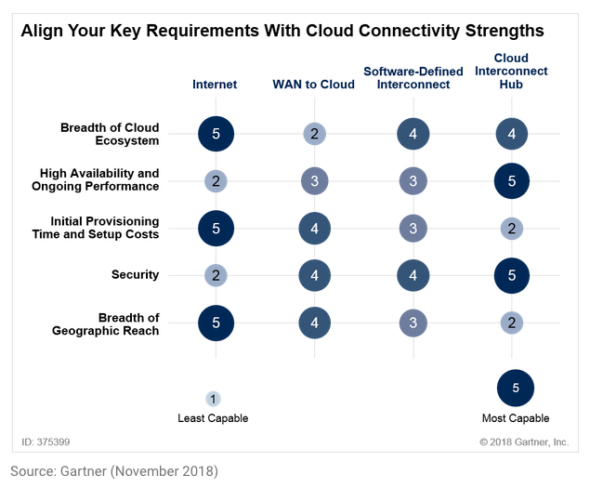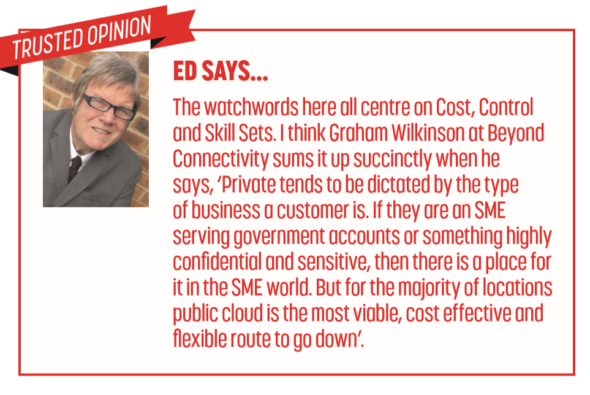
For some time now organisations have had wide choices when it comes to running applications in the cloud. Large government departments needing far greater security have tended to use private clouds as have larger enterprises.
However, more and more large companies not only use the SaaS applications from public clouds but also a mix of the two by running hybrid, private and public clouds together to meet the needs of their business.
Comms Business asks;
What are conditions and needs for a company to use hybrid, private or public clouds?
Intercity Technology’s Cloud, Security and Data Centre Managing Director, Geraint Talbot-Davies, says that before an organisation can agree which Cloud option is best for them, IT professionals need to start by thinking carefully about their business’s objectives and the applications they are using.
“Given the rapid development of digital business transformation, it’s now unlikely that a company would adopt a single approach as certain solutions suit particular applications better. Cloud is an application-led marketplace so multiple approaches are usual.
“For a global operator, the use of a multi-cloud approach is a natural choice due to the volume of applications they need to access, but they still retain considerable in-house core application expertise.
“At the other end of the scale, SMEs have mainly preferred to adopt a ‘hybrid’ approach allowing increased freedom to use applications from public as well as private cloud. In fact, around 88 per cent of the SME UK market now follow this hybrid approach to ensure they can develop and access applications tailored specifically to their customers’ requirements.”
Dave Hawkins, Head of Channel Sales at KCOM, says for organisations starting out fresh - without a legacy technology infrastructure - it really shouldn’t be a question of whether to adopt a cloud infrastructure: the question is why wouldn’t you adopt a cloud-centric approach?
Hawkins says, “Organisations in this space mostly include start-ups and digital disruptors – they often reap the greatest benefits because they develop cloud systems from scratch to support their business goals and needs effectively.”
Simon Smith, Chief Executive Officer, Extrinsica Global says that in terms of workloads, the overwhelming majority can now be accommodated in the public or ‘hyperscale’ cloud.
He says, “The exception to this rule would be extremely dated mainframe applications’ although there are several companies that specialise in doing this, if you’re prepared to pay the enormous cost. It is perfectly possible to deliver the current functionality businesses use (often client/server based) from the hyperscale cloud.”
Does this matter? What are the pro’s and con’s?
Carl Boraman, Director of Strategic Alliances at Tollring says the choice of private cloud vs. public cloud is still very much subjective, with no ‘right’ answer – it depends heavily on a service provider’s priorities, vertical markets served, differentiation strategy, and approach to customer experience.
“While a public cloud approach is generally quicker to get up and running and will reduce support and maintenance overheads for the service provider, a private cloud delivers greater control over customer experience when it comes to value added services like those offered by Tollring (specifically business analytics and call recording).
“In a private cloud environment, the service provider can choose when they upgrade to new versions, operate test environments or go deeper into the solution to provide comprehensive user support. Further benefi ts include licence utilisation statistics, control over provisioning, and the opportunity to apply their own branding throughout – even off er multi-tier branding to their customers. For many service providers, who are competing on customer experience like never before, the private option is really important to their business strategy.”
Tim Mercer, CEO of Vapour Cloud told us, “More and more clients are looking for a hybrid approach whereby certain applications and services are delivered in both environments - after all there should be no such thing as a one-size-fi tsall approach. However, many businesses - and in some case their providers - fail to think about the network (more specifically the internet pipe) for the solutions delivered via a public cloud. Th e-pipe may be big enough on a typical day, but in times of need - such as when a backup is urgently required following a ‘disaster’ - the pipe can’t pull the data back and transfer it at the speed required.
“Sometimes the provider will also charge an additional fee in such circumstances which represents unplanned costs. A private cloud connected to a client’s WAN, sometimes therefore comes up trumps as it has added security.”
Patrick Callaghan, Vice President Enablement at DataStax, says companies are evaluating the approaches that suit them.
“Do they want to commit to working with a single cloud provider, and give up their control and fl exibility? Do they want to run a hybrid, where they look to retain control, but take advantage of cloud? Or do they look at multi-cloud, which can be more complex but also follow the best of breed model? This cloud-native approach offers more flexibility and agility in the long run.
“From a data perspective, using containers and Kubernetes means they can run across multiple clouds helps on the software side. On the database side, you would have to look at the open source database Apache Cassandra to run in hybrid and multi-cloud deployments.”
Graham Wilkinson, Head of Sales at Beyond Connectivity, says there are pros and cons both ways.
He says, “The advantage of multi cloud is that it sits across several networks so it’s always accessible, anytime, anyplace, anywhere. Obviously by its nature a private network is locked down so if there is a problem there are limited options to recover the situation quickly. The biggest concern of public cloud is security but there are several effective ways to minimise the risks.”
Dave Hawkins at KCOM believes that whichever cloud option an organisation selects, one of the main concerns is whether or not it allows their business to function as usual, if not better.
“For example, organisations within the banking industry may need to migrate to a hybrid cloud system, in order to be compliant with new regulations around processes, such as open banking and GDPR, and to ensure the security of their customers’ private data.
“Many new technologies and applications coming into the market are compatible with the public cloud, encouraging these types of organisations to migrate towards a cloud model, to capitalise on emerging technologies.”
Simon Smith at Extrinsica Global says it’s the degree of confusion in the marketplace that matters. “Many organisations, particularly the upper midmarket and enterprises, where security and governance consideration are high on the agenda, are beginning to understand the transformational difference that basing their solutions in the hyperscale cloud can make to them. Using a combination of hyperscale software, platform and infrastructure services enables complete, coherent solutions to be built that will transform the way businesses can operate.
However, there is much disinformation out there about the advantages of the private cloud approach, (largely pedalled by organisations that have yet to sweat the tin-in-a-datacentre assets they own) and businesses are understandably confused and, more to the point, missing out.”

Where does the channel, who sell mainly to SMEs, fit in to this mix and who is keeping up with the skills required to do so successfully?
Geraint Talbot-Davies, says, “At Intercity Technology, we specialise in working with British businesses and are seeing a shift in such organisations back to the hybrid approach, which allows them to retain data sovereignty while also providing security assurances and increased assistance with IT workloads – everyone has a lot to do so they need help!
“For many, continuance and expansion of private-hybrid cloud is due to a desire to have greater control and to know who they are talking to and where their data is held. It also represents a need for applications which are ‘mission critical’ to be more specifically tailored to that business’s particular requirements. What’s more, businesses need applications which can be easily adapted to diff erent markets and territories, to refl ect the geographies they operate in. Th is fl exibility is becoming more important to companies aiming to stand out from the crowd in a saturated marketplace.
“It’s clear there is no ‘onesize-fits-all’ approach to cloud. That’s why we work closely with organisations to really understand their business and customer needs so we can recommend an approach which will genuinely deliver on their overarching commercial objectives.”
Patrick Callaghan at DataStax says the make-up of the channel is changing - from products and services to more software development and consulting.
“Partners have to understand the business pressures that companies face, how they are considering software and cloud to solve those problems, and then guide customers through some of the pitfalls and emerging best practice areas. This is still a nascent market where the big systems integrators are currently leading, but channel companies with strong market expertise and cloud skills can easily compete.
“The biggest issue is how much companies are willing to tie themselves to specifi c approaches - should you commit to a cloud vendor now and run the risk of them changing their products in the future? I’d suggest most enterprises are better served by keeping control of their data and running independently of any one cloud provider, so they can keep themselves in the driving seat. For partners, helping customers keep control of their cloud strategies over time is a great approach for the future.”
Dave Hawkins at KCOM says that resellers thrive when they appreciate their customers’ needs and become their trusted advisor, knowing the exact solutions they are looking for.
“However, when it comes to delivering and executing complex cloud requirements, some resellers lack the technical accreditations or expertise required. This is where the assistance of accredited, proven MSPs comes in. MSPs often have a multitude of transferable experience that can be applied across various sectors for resellers to draw on.”

Often multiple sectors suff er from similar technology challenges too; even if the types of products or solutions they sell to customers differ. For example, most organisations need a form of cloud, internet and voice access. By working with established MSPs, who can support with technology requirements, they can then focus on defining their role with clients further as trusted advisers.
Another point to make is that Microsoft and Amazon rely on their partner networks to extend the reach of their solutions. Th is makes it key for resellers to consider their partnerships with MSPs and technology vendors in this cloud space.”
Simon Smith at Extrinsica Global points out that the Channel need to recognise that they need to provide their customers with business solutions – the days of reselling resources are over.
“SME solution requirements are generally uncomplicated and a range of solution services can be developed to meet these needs but it will require expertise, which is scarce and expensive. Could this be the new value-adding role that needs to be provided by distributors? - our experience as a hyperscale cloud solution provider is that we’re too busy servicing the rapidly growing upper mid-market and enterprise customers to be able to provide services to the Channel.”
